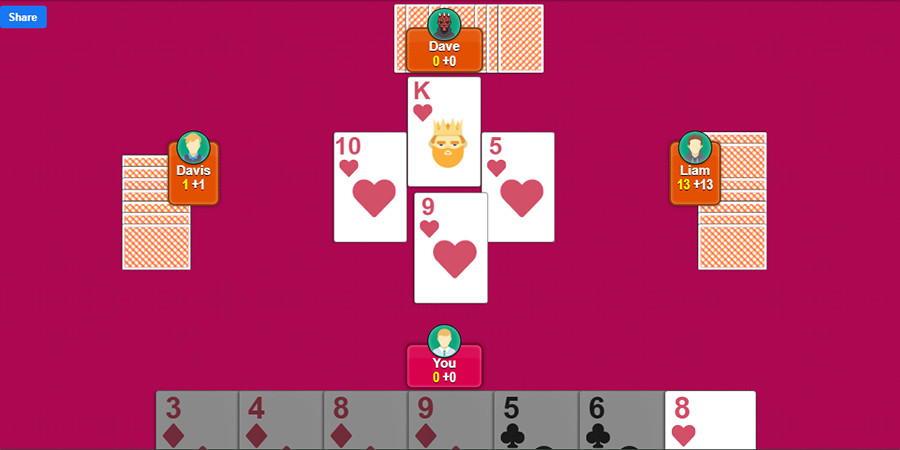

So if A has one heart, B two, C four and D six, A will receive 2 chips from B, 4 from C and six from D making 12 in toto. Otherwise, the player with the lowest number of hearts wins and the others pay that player in chips the number of hearts they took. If a player revokes, they lose the trick and pay the pre-agreed penalty in chips.Ī player taking all 13 hearts pays 13 chips: four to each opponent and one to the table.

The trick is won by the highest card of the led suit and the trick winner leads to the next trick. Players must follow suit if able otherwise may discard any card. If cards are faced in the pack, the dealer reshuffles, offers it for the cut and re-deals.Įldest hand leads to the first trick. If cards are misdealt, the deal passes to the left. The deck is shuffled by the dealer, cut by the player to the right, and then dealt clockwise beginning with eldest hand, the player left of the dealer, until each player has thirteen cards. Players draw a fixed number of chips, typically 25 or 50, which may or may not have a monetary value. A standard 52-card pack of English pattern cards is used, cards ranking from ace (high) down to the two. The aim is to avoid taking any cards of the heart suit in tricks. The game is usually played by four players, but three to six can be accommodated (see below). The following rules are based on those published in The Standard Hoyle of 1887. The game has increased in popularity through Internet gaming sites which, however, usually offer the Black Lady variant while still calling it Hearts, whereas most books maintain the distinction between the two games. Meanwhile, in Britain the game of Black Maria, with its additional penalty cards in the suit of spades, emerged in 1939 and, both it and another offshoot, Omnibus Hearts, are "sufficiently different and popular to justify descriptions as separate games." Today this feature is a common element of modern Black Lady. The slam is known as "shooting the moon" and first appeared in Britain in 1939 in a variant of Hearts called Hitting the Moon. In the 1920s, the J ♦ variation (ten positive points) was introduced, and sometime later the scoring was reversed so that penalty points were expressed as positive instead of negative. To begin with, Black Lady did not have the option of "shooting the moon" that came later. This new variant has since become the standard game of the Hearts group in America where it is often, somewhat confusingly, also called "Hearts". In 1909, the Q ♠ was added as the highest penalty card in a variant called either Discard Hearts, after the new feature of passing unwanted cards to other players after the deal, or Black Lady, after the nickname for the Q ♠. The second scoring scheme was: Ace 5, King 4, Queen 3, Jack 2 and all pips 1 chip each. The first was the precursor to Spot Hearts whereby the cards of the heart suit cost the following in chips: Ace 14, King 13, Queen 12, Jack 11 and pip cards their face value. Two scoring variants were mentioned under the name 'Double or Eagle Game'. The basic format has changed little since.
#Aol hearts card game full#
It was a no-trump, trick-taking game for four players using a full pack of cards, the aim being to avoid taking any hearts in tricks. It described Hearts as "a most pleasant game, highly provocative of laughter".

Hearts itself emerged in the United States during the 1880s, The Standard Hoyle of 1887 reporting that it had only been played there for "the last five years" and was "probably of German origin". A similar game called "Four Jacks" centred around avoiding any trick containing a Jack, which were worth one penalty point, and J ♠ worth two.
#Aol hearts card game plus#
In this game, a penalty point was awarded for each trick won, plus additional points for taking J ♥ or Q ♥ in tricks. The game of Hearts probably originated with Reversis, which became popular around 1750 in Spain. The original game of Hearts is still current but has been overtaken in popularity by Black Lady in the United States and Black Maria in Great Britain. The game is a member of the Whist group of trick-taking games (which also includes Bridge and Spades), but is unusual among Whist variants in that it is a trick-avoidance game players avoid winning certain penalty cards in tricks, usually by avoiding winning tricks altogether. It was first recorded in America in the 1880s and has many variants, some of which are also referred to as "Hearts", especially the games of Black Lady and Black Maria. Hearts is an "evasion-type" trick-taking playing card game for four players, although most variations can accommodate between three and six players. Notes: Hearts, while not trump, award one penalty point each, hence the game's name. 52-card (51 or 54 for 3 or 6 players, 50 for 5)


 0 kommentar(er)
0 kommentar(er)
